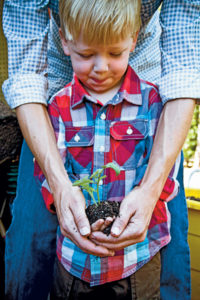Seeds: Winter’s Hope Brings Summer’s Plenty
As the seed catalogs arrive, here’s some advice on what to plant in the new season.
By Linda Askey | Photos By Jamie Cole
A casual observer may think the growing season begins at planting. However, a seasoned gardener knows it begins with a craving for a fresh cucumber or juicy tomato.
That said, we need not limit our activities to just dreaming about the future garden’s bounty. We can and should begin the planning soon. To that end,
we offer a few suggestions on what to plant, when to do it and how best to get the beginnings of your next bumper crop in the ground.
Now, let’s get busy.
Workhorses and Newbies
Before getting your hands dirty, consider your options. Like most experienced gardeners, you probably have your favorite varieties—the selections that grow best in your soil or climate, or simply those that have become a favorite on your family table.
However, it is always fun to try something new, and that’s where neighbors, seed catalogs and your friendly garden columnist really come in handy. Whether they are new to market or new to you, here are a few seed suggestions for an adventure in the garden of 2015.
Tomatoes. Black tomatoes in general have a satisfying, complex flavor. You can try Cherokee Purple, Black Krim, Black from Tula or Black Cherry, to name only a few. Although not technically black, they are dark red, and that makes picking the ripe fruit a treasure hunt among the green leaves. To brighten the trellis and the plate, add a few plants of yellow and orange slicing tomatoes, such as Lemon Boy and Kellogg’s Breakfast, and salad or snack-size tomatoes, such as Yellow Pear and Sun Sugar.
Cucumbers. For cukes that are mild, tender and small-seeded, try growing Diva or the Armenian cucumber. The latter is actually a melon, but you eat it like a cucumber. The thought may not be appealing, but be assured, the reality is. When you have more cucumbers than you can eat or pickle, try cold cucumber-yogurt soup, cucumber-tomato-basil salad (forget the lettuce) and a personal favorite—a long-wise slice on summer sandwiches.
Heirlooms. This is where gardening can really get interesting. Traditionally open-pollinated rather than hybrid, these keepsakes have had many seasons of selection for local climates, often spanning decades of family history. There are ethnic favorites that have traveled far from their origin, such as Russian tomatoes (Paul Robeson or Russian 117), or there are American traditions (Amish Deer Tongue lettuce or Hill Country Red okra). Look for offerings in your state farmer’s bulletin, or consult catalogs that specialize in heirlooms. Often their traits and names are charming, as well as delicious.
It’s always fun to try a few plants of a new selection. In fact, you can dedicate one area of the garden for trialing new selections. Then, if you like something, plant a whole row next season.
When to Plant
Oftentimes, the deciding factor on when to plant is the length of the growing season.
For instance, cold-climate gardeners may only have three to four months to grow frost-free. The key to success is choosing early-maturing and cold-tolerant selections, and then planting them as soon as possible. Often that means setting transplants that have already been growing in a greenhouse for six to eight weeks.
On the other hand, warm-climate gardeners may have two to three months in spring and fall to grow lettuce and members of the cabbage family. A slow start in spring means bolting in summer’s heat; in fall, the result is a thawed, mushy mess. Transplants make a difference by trimming weeks off the time needed in the garden. Gulf Coast gardeners often plant tomatoes in spring for early summer and again in late summer for fall harvest.
Growing Transplants
The economics of a large garden favor sowing seeds directly into the garden, rather than setting out transplants. It’s an obvious choice. However, vegetables that need a quick start and/or an early harvest are natural choices for transplants, either home-grown or purchased. Consider these factors:
Tender seedlings sprouting in garden soil can be killed by slugs, cutworms and damping-off fungus. Transplants grown in pots in a soilless mix have thicker, more mature stems that are less likely to be damaged once they are set into the garden.
Even after the plants get a good, healthy start, growing them to maturity is only possible when the gardener can harvest before pests can do damage. A good example is yellow squash, a plant often killed in early summer by squash vine borer. An early start, often with transplants, is an essential ingredient for squash casserole.
Almost any vegetable can be grown from seeds, started early in pots and transplanted to the garden when the time is right, but the most common are those in the cabbage family: broccoli, Brussels sprouts, cauliflower, broccoli raab (or rabe), collards, kale and, of course, cabbage. Other common transplants are tomatoes and peppers. Where summer is short, hot-weather vegetables like okra and watermelons also need to hit the ground running.





